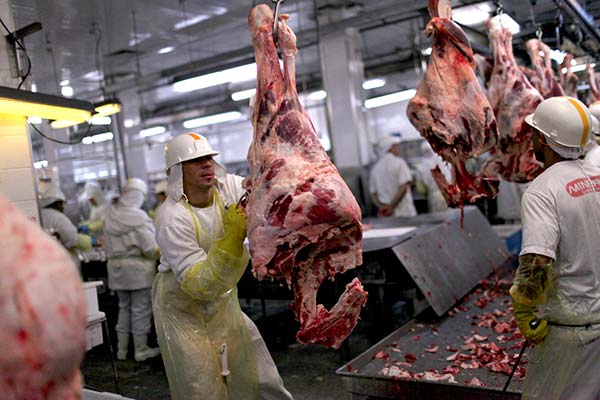
Workers process meat on a production line at the Minerva SA meat processing plant in Barretos, Brazil. (Provided to China Daily)
Shipments to the Chinese mainland and Hong Kong in the first six months of this year were a combined 265,800 tons, up from 161,000 tons a year earlier, industry data show. Total exports to all countries rose 12 percent to 736,000 tons.
"There's a lot of tailwinds for the Brazilian industry at this moment," Justin Sherrard, an animal-protein global strategist at Rabobank, said in a telephone interview from Utrecht, Netherlands.
Brazil almost missed out. A single positive test for mad cow disease in 2012 led to import bans by China and other countries, including South Korea and Japan. The case was considered a "negligible risk," based on criteria established by the World Organization for Animal Health, because the animal never made it into the food chain. That meant a quicker path to lifting the ban, which China did in May 2015.
While some forms of Brazilian meat are still restricted, like organs or boned meat, China now permits most common meat cuts including steaks and ground beef, though most of the purchases are the low-end cuts used in processed meat products. With most of the so-called premium markets including Japan and South Korea still closed to Brazilian beef, most of the country's shipments of prime cuts like steaks end up in Europe.
"China is emerging as the first alternative to Europe for Brazil's premium beef," Antonio Camardelli, head of Brazil's beef industry group, Abiec, said in a telephone interview from Sao Paulo. "There's still a lot of room to increase exports of gourmet beef to China."
There are signs that demand will slow from China buyers who are "pressuring prices down," Mercosul's Gularte said. Still, Brazilian shipments to China this year will be twice what they were in 2015, he said.
Asia represented 26 percent of exports for Minerva in the year ended in March, making it the main destination for Sao Paulo-based company's exports. That's up from 18 percent a year before.
"There are consumers that are willing to pay a premium for having a differential," Fernando Galletti Queiroz, chief executive officer of Minerva SA, said in an interview in Sao Paulo. "The price gap to Europe is shrinking."
Not only purchasing agricultural products from Brazil, China has also invested more in both Brazil and Latin America's manufacturing, financial and infrastructure sectors to boost growth as it adjusts its trade structure and diversifies investment categories under current global business setting.
China's outbound investment in the non-financial sector of Latin America reached $21.4 billion in 2015, surging 67 percent year-on-year. Its investment mainly flowed into countries including Brazil, Venezuela, Argentina and Ecuador, data from the Ministry of Commerce show.


















































